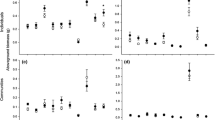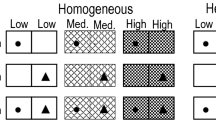Abstract
Few studies have examined plant–soil relationships in competitive arenas between exotic and native plants in the western United States. A pair-wise competitive design was used to evaluate plant–soil relationships between seedlings of the exotic annual grasses Bromus tectorum and Taeniatherium caput-medusae and the native perennial grasses Elymus elymoides and Pseudoroegneria spicata. Two soils were tested: an arid soil (argid) occupied by E. elymoides and presently invaded by B. tectorum and a high elevation, high organic matter, soil (aquept) where none of the tested species would typically occur. Plant growth proceeded for 85 days at which time above-ground biomass and tissue nutrient concentrations were quantified. Soil also was collected from the rooting zone beneath each species and analyzed for various nutrient pools. The exotic species had significantly greater above-ground biomass than the natives and grew far better in the aquept soil than the argid soil. Growth of B. tectorum, and to some degree, T. caput-medusae was suppressed in intraspecific competition and enhanced, especially in the aquept soil, when competing with the natives. Although not significant, biomass of natives strongly trended downward when competing with the exotic grasses. Overall, concentrations of tissue nutrients were minimally affected by competition, but natives tended to be more negatively affected by competition with exotics. Except for phosphorus (P), all species had significantly greater nutrient concentrations when growing in the aquept soil compared to the argid soil. In both soils, exotics had significant greater tissue concentrations of manganese (Mn), magnesium (Mg), and iron (Fe), while natives had significantly greater nitrogen (N). Species affects on soil nutrient pools occurred mostly in the aquept soil with exotic species significantly decreasing pools of available N, potentially available N, and soil-solution pools of calcium (Ca2+), potassium (K+), and magnesium (Mg2+) relative to natives. Overall, the data suggest that, in the seedling state, B. tectorum is a superior competitor. Moreover, when the natives compete intra- or interspecifically, particularly in the aquept soil, availability of N and other nutrients in their rooting zone is consistently greater than when they compete interspecifically with the exotic grasses. These data suggest the exotics are able to co-opt nutrients in the rooting zone of the natives and perhaps gain a competitive advantage.



Similar content being viewed by others
References
Adair CE, Burke IC, Lauenroth WK (2008) Contrasting effects of resource availability and plant mortality on plant community invasion by Bromus tectorum L. Plant Soil 304:103–115. doi:10.1007/s11104-007-9525-9
Arredondo KT, Johnson DA (2002) Root architecture and biomass allocation of three range grasses in response to nonuniform supply of nutrients and shoot defoliation. New Phytol 143:373–385. doi:10.1046/j.1469-8137.1999.00460.x
Bever JD (1993) Soil community feedback and the coexistence of competitors: conceptual frameworks and empirical tests. New Phytol 157:465473
Bever JD (1994) Feedback between plants and their soil communities in an old-field community. Ecol 75:1965–1977. doi:10.2307/1941601
Bias HP, Vepachedu R, Gilroy S, Callaway RM, Vivanco JM (2003) Allelopathy and exotic plant invasion: from molecules and genes to species interactions. Sci 301:1377–1380. doi:10.1126/science.1083245
Blank RR, Young JA (2004) Influence of three weed species on soil nutrient dynamics. Soil Sci 169:385–397. doi:10.1097/01.ss.0000128013.15268.17
Blank RR, Svjecar TJ, Riegel GM (1995) Soil genesis and morphology of a montane meadow in the northern Sierra Nevada Range. Soil Sci 160:136–152. doi:10.1097/00010694-199516020-00007
Blank RR, Trent JD, Young JA (2002) Sagebrush communities on clayey soils of northeastern California: a fragile equilibrium. In: Clary WP, McArthur ED, Bedunah D, Wambolt CL (compliers) Proceedings–symposium on ecology and management of riparian shrub communities. Gen Tech Rep INT-289. USDA-Forest Service, Intermountain Research Station. pp 198–202
Blossey B, Nötzold R (1995) Evolution of increased competitive ability in invasive nonindigenous plants: a hypothesis. J Ecol 83:887–889. doi:10.2307/2261425
Bradley MA, Mustard JF (2005) Identifying land cover variability distinct from land cover change: cheatgrass in the Great Basin. Remote Sens Environ 94:204–213. doi:10.1016/j.rse.2004.08.016
Bremner JM, Mulvaney CS (1982) Nitrogen-Total. In: Page AL (ed) Methods of soil analysis, part 2 chemical and microbiological properties. ASA, Madison, WI, pp 595–624
Bundy LG, Meisinger JJ (1994) Nitrogen availability indices. In: Weaver AL (ed) Methods of soil analysis, part 2 microbiological and biochemical properties. SSSA, Madison, WI, pp 951–984
Burke MJW, Grime JP (1996) An experimental study of plant community invasibility. Ecol 77:776–790. doi:10.2307/2265501
Callaway RM (1995) Positive interactions among plants. Bot Rev 61:306–340. doi:10.1007/BF02912621
Callaway RM (2002) The detection of neighbors by plants. Tends Ecol Evolution 17:104–105
Callaway RM, Thelen GC, Rodriguez A, Holben WE (2004) Soil biota and exotic plant invasion. Nature 427:731–733. doi:10.1038/nature02322
Casper BB, Jackson RB (1997) Plant competition underground. Annu Rev Ecol Syst 28:545–570. doi:10.1146/annurev.ecolsys.28.1.545
Clausnitzer DW, Borman MM, Johnson DE (1999) Competition between Elymus elymoides and Taeniatherum caput-medusae. Weed Sci 47:720–728
Crooks JA (2002) Characterizing ecosystem-level consequences of biological invasions: the role of ecosystem engineers. Oikos 97:153–166. doi:10.1034/j.1600-0706.2002.970201.x
Davis MA, Grime JP, Thompson K (2001) Fluctuating resources in plant communities: a general theory of invasibility. J Ecol 88:528–534. doi:10.1046/j.1365-2745.2000.00473.x
D’Antonio CM, Vitousek PM (1992) Biological invasions by exotic grasses, the grass/fire cycle, and global change. Annu Rev Ecol Syst 23:63–87
Dietz H, Edwards PJ (2006) Recognition that causal processes change during plant invasion helps explain conflicts in evidence. Ecol 87:1359–1367
Ehrenfeld JG, Ravit B, Elgersma K (2005) Feedback in the plant–soil system. Annu Rev Environ Resour 30:75–115. doi:10.1146/annurev.energy.30.050504.144212
Gee GE, Bauder JW (1986) Particle-size analysis. In: A Klute (ed) Methods of soil analysis, Part 1 physical and mineralogical methods. ASA, Madison WI, pp 383–411
Goldberg DE (1990) Components of resource competition in plant communities. In: Grace JB, Tilman D (eds) Perspectives on plant competition. Academic, New York, pp 27–49
Harris GA (1967) Some competitive relationships between Agropyron spicatum and Bromus tectorum. Ecol Monogr 37:89–111. doi:10.2307/2937337
Harris GA, Wilson AM (1970) Competition for moisture among seedling of annual grasses as influenced by root elongation at low temperatures. Ecol 51:530–534. doi:10.2307/1935392
Hart SC, Stark JM, Davidson EA, Firestone MK (1994) Nitrogen mineralization, immobilization, and nitrification. In: RW Weaver (ed) Methods of soil analysis, Part 2 microbiological and biochemical properties. SSSA, Madison WI, pp 985–1018
Henderson S, Dawson TP, Whittaker RJ (2006) Progress in invasive plants research. Prog Phys Geogr 30:25–46. doi:10.1191/0309133306pp468ra
Hobbs RJ, Humphries SE (1995) An integrated approach to the ecology and management of plant invasions. Conserv Biol 9:761–770. doi:10.1046/j.1523-1739.1995.09040761.x
Humphrey LD, Schupp EW (2004) Competition as a barrier to establishment of a native perennial grass (Elymus elymoides) in alien annual grass (Bromus tectorum) communities. J Arid Environ 58:405–422. doi:10.1016/j.jaridenv.2003.11.008
James JJ (2008) Leaf nitrogen productivity as a mechanism driving the success of invasive annual grasses under low and high nitrogen supply. J Arid Environ 72:1775–1784. doi:10.1016/j.jaridenv.2008.05.001
Keddy P, Twolan-Strutt L, Shipley B (1997) Experimental evidence that interspecific competitive asymmetry increases with soil productivity. Oikos 80:253–256. doi:10.2307/3546593
Knick ST, Rotenberry JT (1997) Landscape characteristics of disturbed shrubsteppe habitats in southwestern Idaho (U.S.A.). Landscape Ecol 12:287–297. doi:10.1023/A:1007915408590
Kulmatiski A, Beard KH, Stevens JR, Cobbold SM (2008) Plant–soil feedbacks: a meta-analytical review. Ecol Lett 11:980–992. doi:10.1111/j.1461-0248.2008.01209.x
Kuske CR, Tichnor LO, Miller ME, Dunbar JM, Davis JA, Barns SM, Belnap J (2002) Comparison of soil bacterial communities in rhizospheres of three plant species and the interspaces in an arid grassland. Appl Environ Microbiol 68:1854–1863. doi:10.1128/AEM.68.4.1854-1863.2002
Lambrinos JG (2004) How interactions between ecology and evolution influence contemporary invasion dynamics. Ecol 85:2061–2070. doi:10.1890/03-8013
Liao C, Peng R, Luo Y, Zhou X, Wu X, Fang C, Chen J, Li B (2008) Altered ecosystem carbon and nitrogen cycles by plant invasion: a meta-analysis. New Phytol 177:706–714
Lowe PN, Lauenroth WK, Burke IC (2003) Effects of nitrogen availability on competition between Bromus tectorum and Bouteloua gracilis. Plant Ecol 167:247–254. doi:10.1023/A:1023934515420
Mack RN (1981) Invasion of Bromus tectorum L. into Western North America: an ecological chronicle. Agro-ecosyst 7:145–165. doi:10.1016/0304-3746(81)90027-5
McLean EO (1982) Soil pH and lime requirement. In: Page AL (ed) Methods of soil analysis, part 2 chemical and microbiological properties. ASA, Madison, WI, pp 199–224
Melgoza G, Nowak RS, Tausch RJ (1990) Soil water exploitation after fire: competition between Bromus tectorum (cheatgrass) and two native species. Oecologia 83:7–13. doi:10.1007/BF00324626
Monaco TA, Johnson DA, Norton JM, Jones TA, Connors KJ, Norton JB, Redinbaugh MB (2003) Contrasting responses of Intermountain West grasses to soil nitrogen. J Range Manage 56:282–290. doi:10.2307/4003820
Mubarak A, Olsen RA (1977) A laboratory technique for appraising in situ salinity of soil. Soil Sci Soc Am J 41:1018–1020
Nelson DW, Sommers LE (1982) Total carbon, organic carbon, and organic matter. In: Page AL (ed) Methods of soil analysis, part 2 chemical and microbiological properties. SSSA, Madison WI, pp 539–579
Olsen SR, Sommers LE (1982) Phosphorus. In: Page AL (ed) Methods of soil analysis, part 2 chemical and microbiological properties. ASA, Madison, WI, pp 403–430
Perry DA, Amaranthus MP, Borchers JG, Borchers SL, Brainerd RE (1989) Bootstrapping in ecosystems. Bioscience 39:230–237. doi:10.2307/1311159
Radosevich SR, Stubbs MM, Ghersa CM (2003) Plant invasions: process and patterns. Weed Sci 51:254–259. doi:10.1614/0043-1745(2003)051[0254:PIPAP]2.0.CO;2
Reinhart KO, Callaway RM (2006) Soil biota and invasive plants. New Phytol 170:445–457. doi:10.1111/j.1469-8137.2006.01715.x
Rice EL (1964) Inhibition of nitrogen-fixing and nitrifying bacteria by seed plants. Ecol 45:824–837. doi:10.2307/1934928
Rummell RS (1946) Some effects of competition from cheagrass brome on crested wheatgrass and bluestem wheatgrass. Ecol 27:159–167. doi:10.2307/1932510
Sakai AK, Allendorf FW, Holt JS, Lodge DM, Molofsky J, With KA, Baughman S, Cabin RJ, Cohen JE, Ellstrand NC, McCauley DE, O’Neil P, Parker IM, Thompson JN, Weller SG (2001) The population biology of invasive species. Annu Rev Ecol Syst 2001:305–332. doi:10.1146/annurev.ecolsys.32.081501.114037
Sheley RL, Bingham BS, Svejcar TJ (2008) Crested wheatgrass defoliation intensity and season on medusahead invasion. Rangeland Ecol Manag 61:211–217. doi:10.2111/07-062.1
Stoll P, Prati D (2001) Intraspecific aggregation alters competitive interactions in experimental plant communities. Ecology 82:319–327
Thomas GW (1982) Exchangeable cations. In: Page AL (ed) Methods of soil analysis part 2 chemical and microbiological properties. American Society of Agronomy, Madison, WI, pp 159–166
Thompson K, Hodgson JG, Rich TCG (2006) Native and alien invasive plants: more of the same? Ecography 18:390–402. doi:10.1111/j.1600-0587.1995.tb00142.x
Van Breemen N, Finzi AC (1998) Plant–soil interactions: ecological aspects and evolutionary implications. Biogeochem 42:1–19
Vilá M, Weiner J (2004) Are invasive plant species better competitors than native plant species?—evidence from pair-wise experiments. Oikos 105:229–238. doi:10.1111/j.0030-1299.2004.12682.x
Wolfe JE, Klironomos JN (2005) Breaking new ground: soil communities and exotic plant invasion. Bioscience 55:477–487. doi:10.1641/0006-3568(2005)055[0477:BNGSCA]2.0.CO;2
Young JA, Evans RA (1970) Invasion of medusahead into the Great Basin. Weed Sci 18:89–97
Young K, Mangold J (2008) Medusahead (Taeniatherum caput-medusae) outperforms squirreltail (Elymus elymoides) through interference and growth rate. Invasive Plant Sci Manage 1:73–81. doi:10.1614/IPSM-07-021.1
Young JA, Trent JD, Blank RR, Palmquist DE (1998) Nitrogen interactions with medusahead (Taeniatherum caput-medusae ssp. asperum) seedbanks. Weed Sci 46:191–195
Acknowledgments
I thank Ms. Tye Morgan and Ms. Fay Allen for considerable assistance in maintaining the experiment and quantification of attributes.
Author information
Authors and Affiliations
Corresponding author
Additional information
Responsible Editor: Hans Lambers.
Rights and permissions
About this article
Cite this article
Blank, R.R. Intraspecific and interspecific pair-wise seedling competition between exotic annual grasses and native perennials: plant–soil relationships. Plant Soil 326, 331–343 (2010). https://doi.org/10.1007/s11104-009-0012-3
Received:
Accepted:
Published:
Issue Date:
DOI: https://doi.org/10.1007/s11104-009-0012-3




